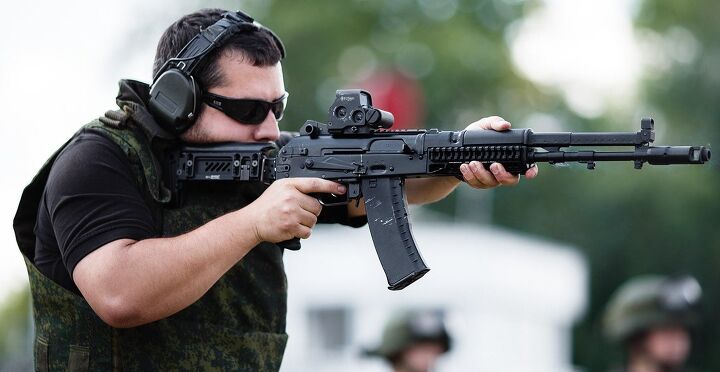After more than five years of promises, presentations and demonstrations, the first balanced recoil sporting rifles (SR-1) recently hit the shelves in Russian gun stores.
However, until July 17, for once, Russian and American gun enthusiasts will be in the same boat, unable to buy the new rifle.
In the US, you cannot buy it because of sanctions and import ban, in Russia because of national gun ban ordered for the entire duration of FIFA soccer World Cup.
Since we in Russia cannot even go to the range until July 17, it seems like a good time to reflect on the history of balanced recoil rifles and the evolution of the concept that took place in the last few years.
The origins of the concept are very hard to pinpoint. When one of my colleagues and friends started his research, he went as far as 1908, when a similar idea received a patent for a machine gun designed by Ludwig Mertens.
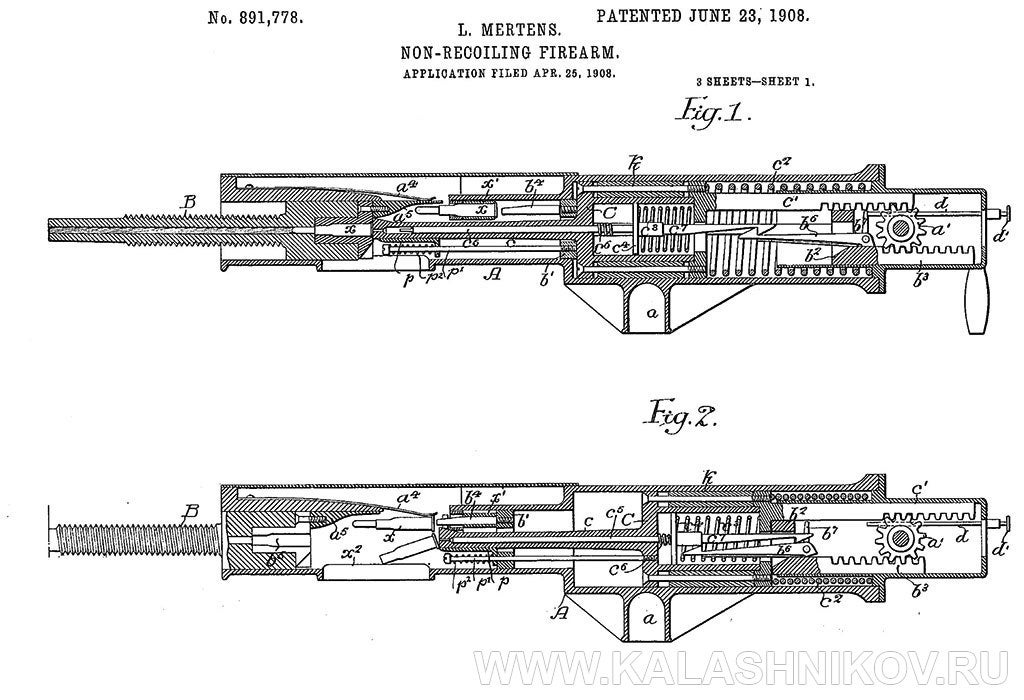
The patent from 1908 with the “non-recoiling” machinegun. Picture courtesy of “Kalashnikov” gun magazine.
To cut the introduction and get straight to the point, we will only talk about balanced recoil rifles made in Izhevsk.
First, what is a balanced recoil system? The concept is straightforward and easy to understand. In an AK, when a massive bolt carrier moves back and hits the rear trunnion (back of the receiver), it creates a lot of instability and causes the weapon to move (recoil).
With this famous slow-mo footage, you can really see how much the movement of a bolt carrier moves an entire weapon
The obvious way to counter that would be to decrease the weight of the bolt carrier or at least change the recoil spring to slow the carrier down.
However, when you slow down the bolt carrier, you decrease the reliability of the weapon, which is never tolerated in (Soviet) Russia.
With its fast-moving and massive bolt carrier, AK generally can “chew through” sand, dirt, show and even some light and watery mud. Therefore, a different solution was needed, and that is where balanced recoil came into play.
The following video explains the principle rather well:
To counter the impulse of the bolt carrier moving back, a special rod moves forward at precisely the same time. Both counter balancing rod and bolt carrier are connected to the gas system and linked to each other via a gear.
The first balanced recoil system weapons developed in Izhevsk were AL-4, AL-6 and AL-7 assault rifles. None of those weapons were used in the army in any capacity except for some field trials, and for a long time, they remained hidden at the armory of the R&D center.
At the same time, CA-006 assault rifle with the balanced recoil system, developed in Kovrov, participated in trials and almost won, competing against what will later become AK74.
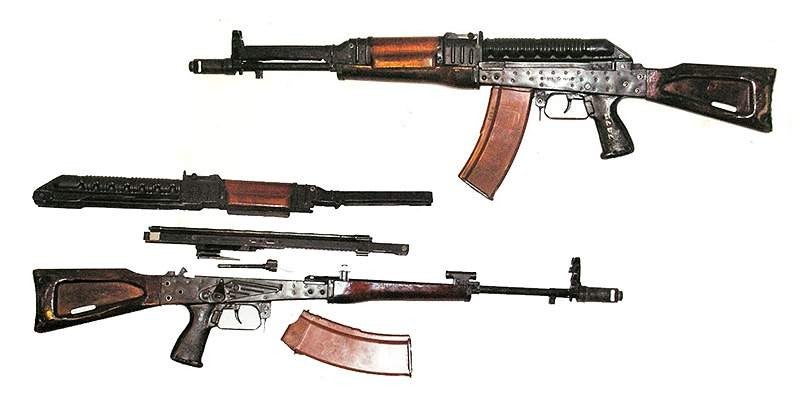
CA-006 experimental assault rifle with the balanced recoil system
By the end of the 90s, Izhmash realized, that factory needs to introduce a new assault rifle.
Despite everyone’s best effort, users rejected previously developed “wunderwaffe,” Nikonov AN-94, and the factory had to come up with something that would be modern, more effective, but realistic regarding production cost.
That is when AK 107 was developed. The weapon’s central idea was based on two very logical concepts: first, already proven balanced recoil system that was used by other manufacturers at the trials, second – massive use of existing AK parts and assembly units, which would bring down the cost in mass production.
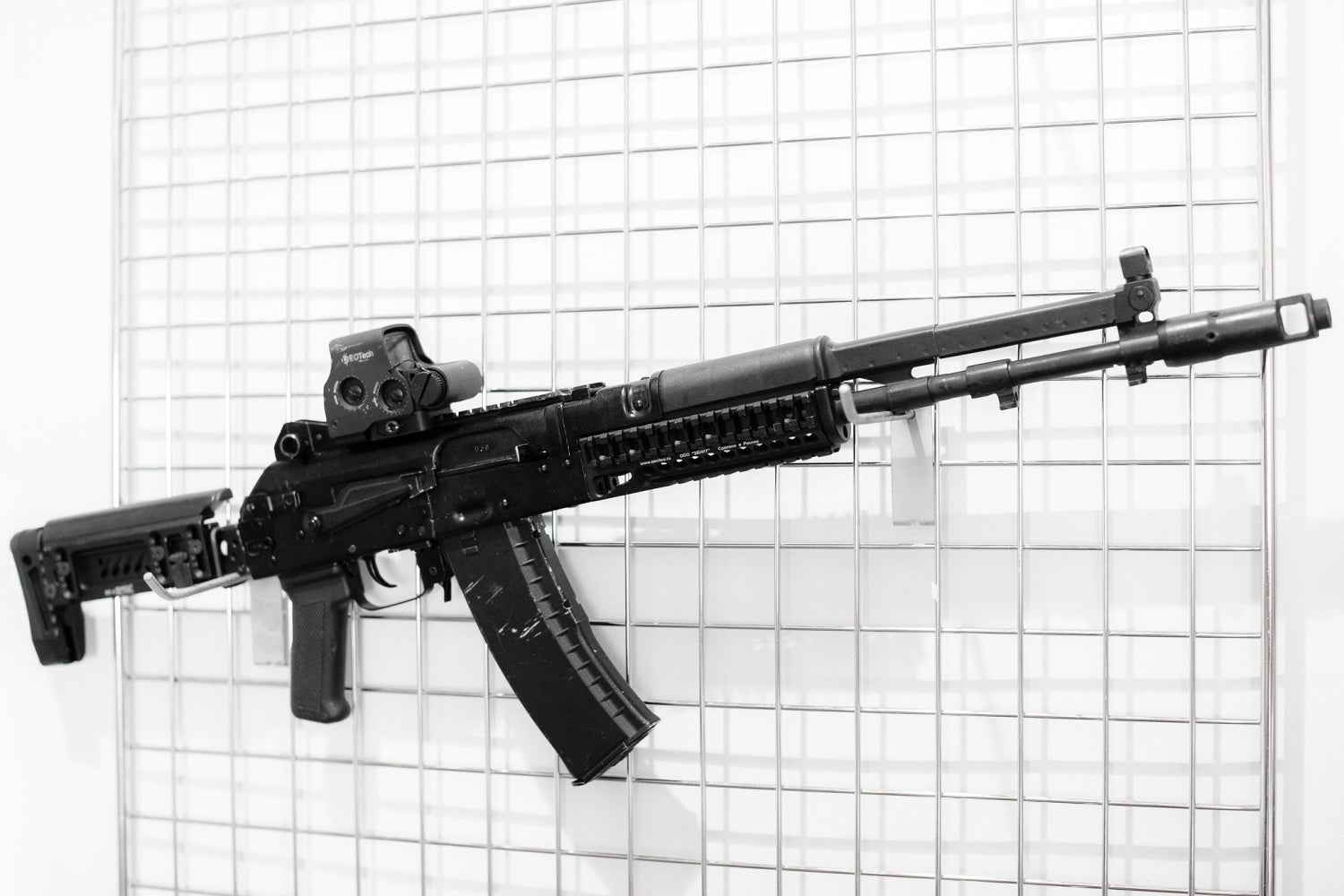
A small batch of guns was built, but it just wasn’t the right time.
In the late 90s and early 2000s, the Russian army was more concerned with its survival than new assault rifles. For over ten years, AK 107 remained as a solid showstopper at any Izhmash live-fire demonstration, but military or LE units never adopted it.
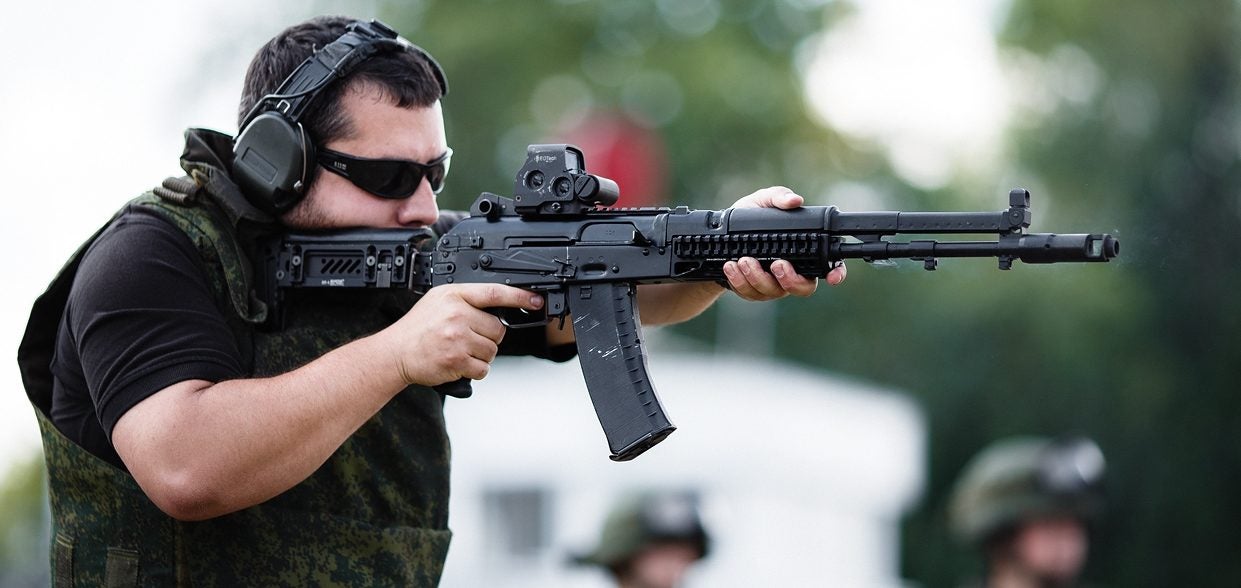
Author of the article, shooting the last version of AK 107 during a live-fire demonstration (August 2014). Note the Picatinny rail on the receiver cover.
The opportunity presented itself ten years after when the “Ratnik” program was established. With all the new gear, body armor, uniforms, Russian army also wanted to change its primary assault rifle.
A new version of AK 107 was developed, and it was even shown to the public in 2012: https://www.thefirearmblog.com/blog/2012/09/27/improved-ak-107-60-round-magazine-holo-sight/
But new chief design engineer of Izhmash, Vladimir Zlobin, decided that he can design a much better weapon for the upcoming trials. That is when the history of AK12 started and the tale of AK 107 ultimately ended.
There is not much footage of AK 107 in action, but this video gives a very good idea of AK107 and its capabilities
We all know that “when one story ends, another story begins.” And, when the AK107 went quietly into the night, the new project was born – Saiga 107.
The credit for this idea goes to Vsevolod Ilin, a famous Russian competition shooter, who is now a two-time IPSC shotgun world champion and seven-time Russian IPSC national champion. In 2012, IPSC in Russia was becoming more popular, and the shooters wanted an alternative to AR-15, something with little recoil, good accuracy, and well thought out optic mount.
The first version of Saiga 107 was presented in March 2013 at the IWA exhibition in Germany.

Saiga 107 (version 1) demonstrated at IWA exhibition in Germany.
The first prototype was not around for a very long time, but it already had many of the distinct features that carried over into the final version: ambidextrous charging handles, button safety, muzzle brake and collapsible M4 style stock.
The second version was ready very soon after.
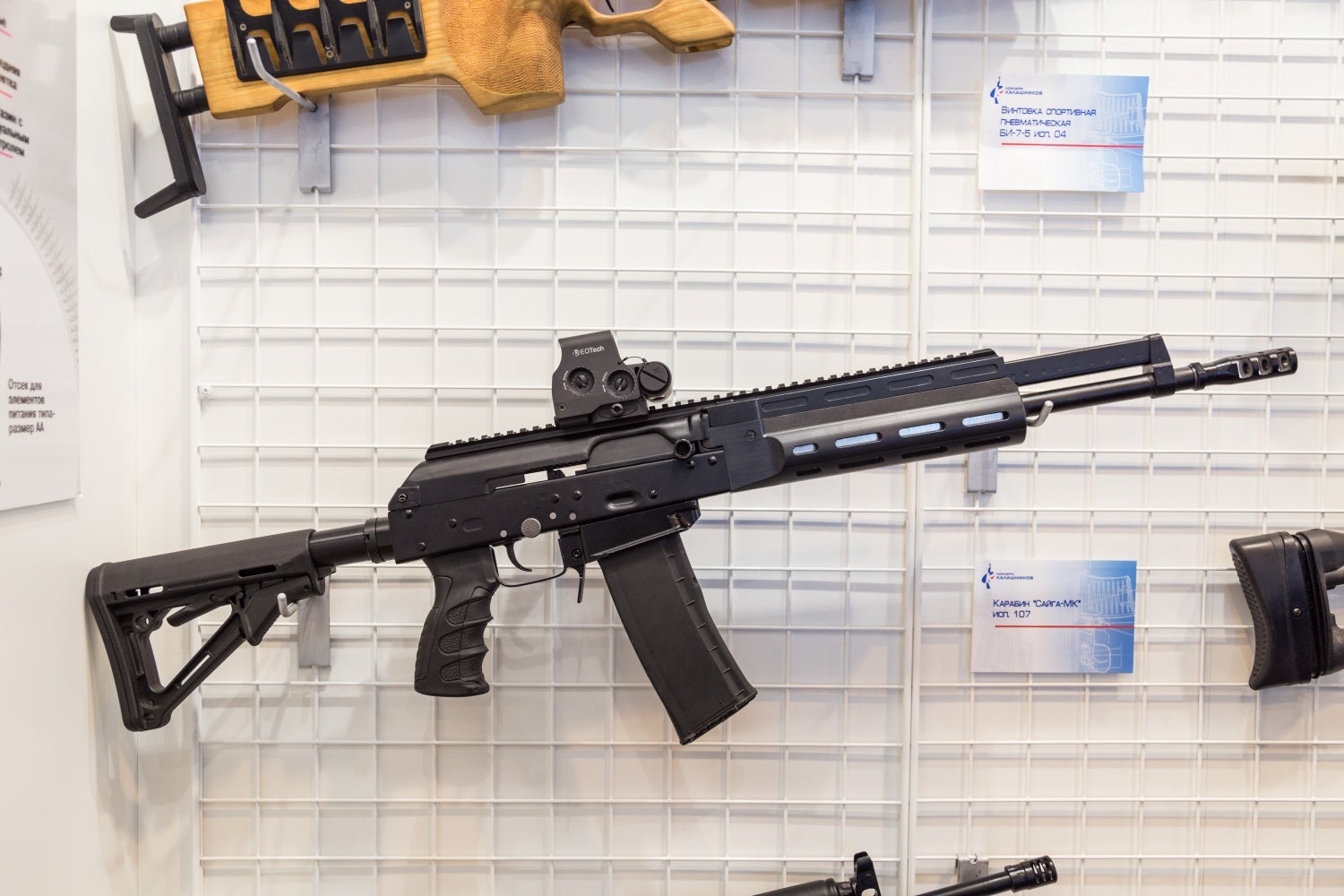
The second version of Saiga 107
In September 2013, the second version was showcased at the annual live-fire demonstration in Izhevsk. To highlight the lack of recoil, a Saiga 107 was shot along with an AR15 in a pretty odd comparison:
For the next couple of years, the Saiga 107 remained to be one of the most anticipated semi-automatic rifles on the Russian civilian market. Those who had a chance to try it on the range were impressed.
Alexei Puchugin, 4-time IPSC Russian national champion shoots Saiga 107
Felt recoil was similar to 22 LR, and if you adjust the compensator, shooting experience was unforgettable. The sound, thanks to the muzzle device, was overwhelming, but the scope reticle hardly moved at all.
In early 2015, the new version of Saiga 107 was developed, with only two prototypes produced. The new version featured giant and heavy full-length KEY-MOD rail, ambidextrous safety selector lever and a new name – AK-15.
Author, shooting AK-15 (June 2015).
The situation took a somewhat difficult turn. Certain people in the company wanted the new rifle to be released ASAP, but other people, including me, were not very happy with the sudden design change. The argument went on and on until someone made an interesting suggestion.
In June 2015, IPSC European Rifle Championship was held in Hungary. Hundreds of the best IPSC rifle shooters were coming to this huge 7-day competition from all over the world. Why not let them decide what future balanced recoil sporting rifle should be?
Vsevolod took this new prototype with him, and for seven days, I was in the test firing bay, offering competitors to shoot the rifle in exchange for feedback. We provided some free ammo for everyone, and shooters could bring their own 5.56 ammunition if they wanted to shoot more.
One of the competitors from Sweden, Eric B, wrote a post about it on TFB: https://www.thefirearmblog.com/blog/2015/09/01/kalashnikov-ak-15-saiga-107-review/

Eric B, the competitor from Sweden, shoots AK-15 prototype in the test-fire bay
The feedback was extremely valuable. Our compensator, previously tested only with Russian ammo, did not work that well with other, hotter loads. New ambidextrous safety was annoyingly pushing on the palm of the hand. The stock was too low and desperately needed a cheek riser.
In less than a week, we were able to collect valuable feedback from most of the top-level international rifle shooters – an opportunity that does not present itself very often.
Based on this feedback, R&D for the rifle continued, and AK-15 prototype never went into production. Later, the name “AK-15” was used for the final version of AK12 chambered in 7.62×39.
A year later, in August 2016, the final version of the rifle was ready.
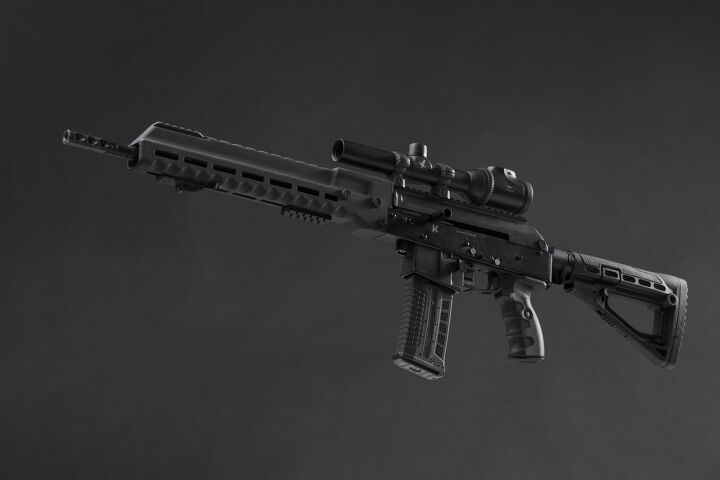
SR-1 balanced recoil sporting rifle. Picture courtesy of Valery Moroz, chief photographer of Kalashnikov Media. More pictures at: https://kalashnikov.media/media/photogallery/4521920
Almost everything changed – instead of 5.56 Saiga mags, new prototype used STANAG 5.56 mags, and stock mount point was raised up about an inch to help with proper cheek weld. The magazine release is similar to AR15, bolt release is in front of the trigger guard and reminds of Bushmaster ACR. The receiver cover and handguard were both completely redesigned.
The following video with English subtitles gives a pretty good rundown of the main features.
Over the years, I shot a lot of rounds through different variants of this rifle. Shooting is always fun, but a balanced recoil weapon is an experience unto itself. Shooting it feels like firing a gun in a computer game or VR simulation – the sound is there, but you don’t feel any recoil.
So, is balanced recoil system a groundbreaking design that would change firearms industry forever?
Not likely. With lightened bolt carriers, adjustable gas blocks and compensators, you can get similar results without completely redesigning the gun.
However, balanced recoil system is indeed different from what we are used to, interesting and quite effective. Three things that, in my opinion, are lacking in most of the “innovative products” in the firearms industry worldwide in the last 50 years.
 Your Privacy Choices
Your Privacy Choices
